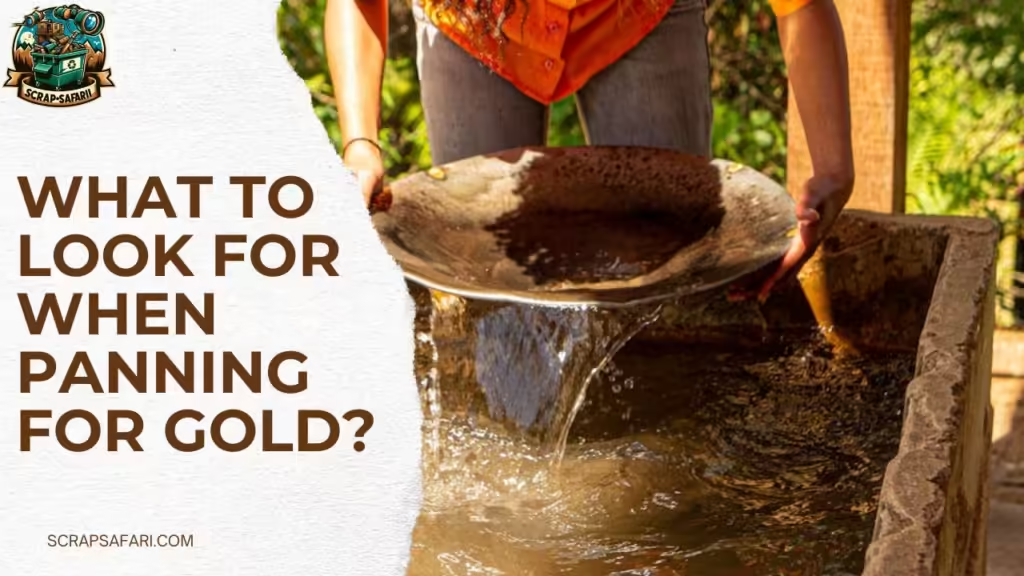Gold can be found in two main forms: placer gold and lode gold. Placer gold refers to small nuggets or flakes of gold that have been eroded and washed away from their source, typically a lode deposit. These particles are then transported and deposited by water action in streams, rivers, and other alluvial environments. Placer gold is the primary target for recreational gold panning and prospecting.
Lode gold, on the other hand, refers to gold that is still embedded within solid rock formations, often in veins or mineralized zones. This is the source of placer gold, as the erosion and weathering of these lode deposits over time release the gold particles into waterways.
Rivers and streams play a crucial role in the deposition of placer gold. As water flows, it carries and concentrates heavy minerals like gold due to their high density. Gold particles are deposited in areas where the water flow slows down or encounters obstructions, such as bends, eddies, or behind boulders. The constant action of water sorting and depositing materials based on their weight and density creates natural traps for gold, forming placer deposits along the waterways.
Geological Indicators of Gold
Changes in rock color can often signal the presence of gold deposits. Mineral solutions containing iron and other metals can bleach or discolor rocks, stripping away their natural hues. This bleaching effect is commonly seen in areas with gold mineralization.
Iron staining and gossans (iron-bearing weathered materials) are another telltale sign of potential gold deposits. When iron-rich minerals oxidize and break down, they leave behind reddish-brown or yellowish stains on the surrounding rocks and soils. These stains can indicate the presence of mineralized zones where gold may be found.
Quartz veins are a familiar sight for many prospectors, as gold is frequently found within or near these distinct rock formations. Quartz is a common gangue mineral associated with hydrothermal gold deposits, making quartz veins prime targets for exploration.
Certain rock types are more likely to contain gold than others. Igneous rocks like granite and metamorphic rocks like schist and gneiss are often good sources of gold, as the extreme heat and pressure involved in their formation can concentrate gold from surrounding areas. Sedimentary rocks like conglomerates and sandstones can also host placer gold deposits.
Rock contact zones and faults are areas where different rock types meet or where rocks have been fractured and displaced. These zones can act as pathways for mineral-rich fluids, making them prime locations for gold deposition. Faults and shear zones are especially promising, as the movement and fracturing of rocks can create spaces for gold to accumulate.
Finally, the topography of an area can provide clues about the potential for gold deposits. Mountainous regions with steep terrain and abundant erosion are often good targets, as gold can be liberated from its host rocks and concentrated in streams and rivers. Conversely, flat areas with little erosion may not have exposed gold-bearing rocks, making them less desirable for prospecting.
Reading a River for Gold Deposits
Experienced gold prospectors have learned to “read” rivers and streams to identify areas with a higher likelihood of containing gold deposits. Here are some key features to look for:
Cobble Bars
Cobble bars are gravel deposits that form along the edges of a river or stream. As the water flows around bends or obstacles, it loses energy and drops the heavier materials like gold flakes and nuggets. Cobble bars are prime locations to focus your panning efforts.
Black Sand Deposits
Black sands are dense materials like magnetite and hematite that accumulate in areas of low water flow. Because gold is also a heavy material, it often concentrates in these black sand deposits. Look for dark streaks or patches along the inside corners of bends or behind obstructions.
Bends and Obstructions
River bends and obstructions like boulders or fallen trees create natural traps where gold can settle out of the main current. The reduced water flow on the inside of a bend allows the heavier gold particles to drop out. Similarly, obstructions disrupt the flow and cause gold to be deposited just downstream.
By carefully observing the river’s features, you can identify areas that act as natural riffles and traps for gold. Focus your panning efforts in these spots for the highest chances of success.
Techniques for Panning for Gold
Step-by-Step Guide on How to Pan for Gold
- Fill the Pan with Material: Start by filling your gold pan about 3/4 full with material from the area you want to prospect. The best material will be loose gravel and sand from areas with good water flow.
- Break Up Clumps: Use your hands or a small trowel to break up any clumps or compact material in the pan. This will help the gold separate from the lighter materials.
- Add Water: Add water to the pan until it’s nearly full, leaving a few inches at the top.
- Agitate the Pan: Hold the pan under water with one hand gripping the rim. Give it a vigorous side-to-side shaking motion to agitate the material and allow the gold to settle to the bottom.
- Tilt and Discard Lighter Materials: Tilt the pan forward, allowing the lighter materials to spill out. Be careful not to lose any of the heavier materials that may contain gold.
- Repeat: Repeat steps 3-5, adding more water and agitating the pan each time, until you’re left with only the heaviest materials, including any potential gold.
- Inspect the Remaining Material: Carefully pick through the remaining material in the pan, looking for any glints of gold flakes or nuggets.
Tips for Keeping Gold at the Bottom of the Pan
- Use a pan with riffles or ridges on the bottom to help trap the gold.
- Avoid overfilling the pan, as this can cause gold to wash out.
- Agitate the pan gently but thoroughly to allow the gold to settle.
- Work the material in a side-to-side motion rather than a circular motion.
- Add water gradually and avoid creating too much turbulence.
Common Mistakes to Avoid
- Not breaking up clumps of material before panning.
- Panning too quickly or with too much force, causing gold to wash out.
- Overfilling the pan, making it difficult to control the material.
- Failing to inspect the remaining material carefully for small gold pieces.
- Panning in areas with little or no gold potential.
By following these techniques, tips, and avoiding common mistakes, you’ll increase your chances of successfully recovering gold when panning.
Equipment Needed for Gold Panning
For successful gold panning, you’ll need both basic and advanced equipment. The basic essentials include a gold pan, classifier, and snuffer bottle. More advanced setups may incorporate a sluice box and metal detector.
Basic Equipment
Gold Pan: The gold pan is the most crucial piece of equipment for gold panning. These specialized pans are designed with riffles on the bottom to help trap heavy gold particles as you agitate the pan in water. Quality gold pans are typically made from plastic or metal like copper or aluminum.
Classifier: A classifier is a screening device used to separate larger rocks and pebbles from the finer gold-bearing material before panning. This saves time by allowing you to focus just on the smaller concentrate.
Snuffer Bottle: A snuffer bottle is a small bottle with a rubber bulb that allows you to suck up and store any gold flakes or nuggets you find in your pan. It prevents losing your precious findings.
Advanced Equipment
Sluice Box: A sluice box is a longer, elevated channel or trough that uses stream water to separate gold particles from sand and gravel. The heavy gold sinks to the bottom riffles while lighter materials get washed away.
Metal Detector: An underwater metal detector can help identify potential gold deposits before digging or panning an area. It detects metal concentrations beneath sediments in rivers and streams.
Recommended Brands and Where to Purchase
For gold pans, popular and well-made brands include Garrett, Keene, and Coleman. Sluice boxes from manufacturers like Royal Sluice Box and Gold Buddy are excellent choices. Trusted metal detector brands for gold prospecting include Minelab, Garrett, and Fisher.
Many prospecting suppliers sell starter kits with bundled basic equipment. Online retailers like Kellyco, Black Cat Mining, and Prospecting.com offer a wide selection of quality gold panning and prospecting gear.
What to Look for When Panning for Gold
One of the most important skills for any gold prospector is being able to distinguish real gold from fool’s gold, also known as pyrite. While pyrite can sometimes be mistaken for gold due to its golden, metallic appearance, there are several key differences that can help you identify the real deal.
Characteristics of Real Gold vs. Pyrite (Fool’s Gold)
Real Gold:
- Distinct yellow color that doesn’t tarnish or change over time
- Extremely dense and heavy for its size
- Malleable and can be flattened or bent without breaking
- Streak is yellow when scratched on a ceramic surface
Pyrite (Fool’s Gold):
- Brassy, metallic yellow color with a hint of greenish or brownish tint
- Brittle and can easily break or crumble
- Streak is greenish-black or brownish-black when scratched
- Lighter in weight compared to real gold
Simple Tests to Confirm Gold Findings
- The Streak Test: Use a ceramic streak plate or an unglazed tile to scratch the suspected gold piece. Real gold will leave a yellow streak, while pyrite will leave a greenish-black or brownish-black streak.
- The Density Test: Hold the piece in your hand and assess its weight. Real gold is extremely dense and will feel heavier than other minerals of the same size.
- The Acid Test: Apply a small drop of nitric acid to an inconspicuous area of the suspected gold piece. Real gold will not react, while pyrite will dissolve and turn green.
- The Magnet Test: Pyrite is slightly magnetic, while real gold is not magnetic at all. Pass a strong magnet over the piece to see if it is attracted.
- The Bite Test: While not recommended for valuable pieces, you can gently bite down on the suspected gold with your teeth. Real gold is malleable and will show tooth indentations, while pyrite is brittle and will not indent.
Remember, it’s always better to err on the side of caution and have your findings properly tested by a professional before assuming they are real gold. With experience and practice, you’ll develop a keen eye for distinguishing the real thing from fool’s gold.
Ethics and Best Practices in Gold Panning
Respecting claims and private property is crucial when gold panning. Always obtain permission before prospecting on private land and follow all posted signs and regulations. Many areas have active mining claims that prohibit recreational panning without the claim holder’s consent.
Environmental considerations should also be a top priority for responsible gold panners. Avoid damaging riparian areas, disturbing streambeds excessively, or introducing pollutants into waterways. Practice low-impact techniques, fill in any holes dug, and leave the area as you found it. Remember, we are guests in nature’s backyard.
Legal regulations and permits may be required in certain areas before you can legally pan for gold. Research the laws and rules in your intended location, as some regions have specific restrictions or require a recreational mining permit. Failing to comply with local regulations can result in hefty fines. Being an ethical and responsible gold panner ensures the activity remains accessible for future generations to enjoy.

Eli Bryngelson is an expert on gold panning in the United States. As an author for Scrapsafari.com, he shares his knowledge and insights on this popular outdoor activity. Eli has extensive experience in gold panning and is passionate about helping others discover the excitement and rewarding nature of this hobby.
Through Scrapsafari.com, Eli provides detailed guides, tips, and advice for both novice and experienced gold panners. His articles cover a range of topics, including the best locations for gold panning, essential equipment and techniques, safety considerations, and the history and culture surrounding this time-honored tradition.
Readers can connect with Eli through his active social media presence on platforms like Instagram (@bryngelsoneli_) and Facebook (/ebryngelson1), where he shares photos, stories, and insights from his gold panning adventures. With Eli’s expertise and enthusiasm, Scrapsafari.com visitors can embark on their own prospecting journeys and uncover the hidden treasures that lie within the nation’s rivers and streams.


